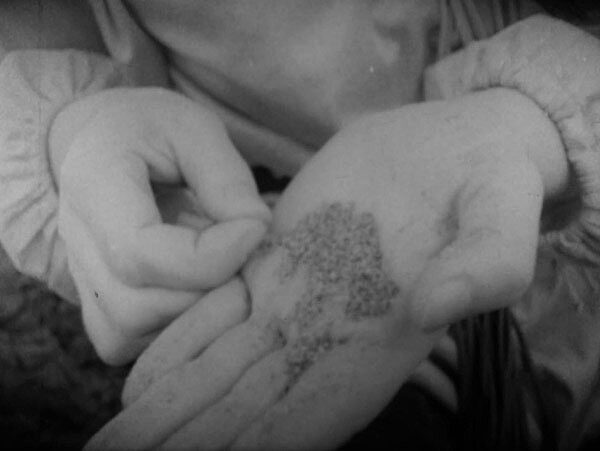Eva van Tongeren at OFFoff



Les mains qui travaillent © Eva van Tongeren
We welcome visual artist Eva van Tongeren with her new film Les mains qui travaillent. For this occasion, she has curated an extensive program titled ‘What a Machine!’, which carefully connects films by and with women that question the role of the camera. We are honored to present Laida Lertxundi’s new installation, Películas, outside the cinema space as part of this evening.
“Every film in this program is a learning process, an attempt, an act of attentiveness. Small deconstructions of production processes that emphasize materiality. Films about relationships between characters, between characters and a landscape, between image and sound. A program reading the skin (of people, film, and landscape) as if they were political, feminist manifestos.
I surrounded myself and my work with filmmakers, educators, artists and writers working on decolonization, feminism, emancipation and civil rights movements. The women I sought out all have the desire to free the body from stigma and shame and carefully transform it into a symbol of solidarity and strength, into something capable of softly demanding and achieving change. Films about orienting and perhaps even more about losing orientation.” (Eva van Tongeren)
→ In the presence of Eva van Tongeren
→ With an introduction by Nancy Vansieleghem
→ In collaboration with De Cinema, Kortfilm.be and Ursula collective
Single-channel installation with Kodak cardboard box and film cans
Películas exemplifies Lertxundi’s collaborative, deconstructivist approach to filmmaking, as well as her ongoing interest in landscape as both an artistic tradition and inhabited environment. In the film, we see two characters gazing at an odd, half-constructed horizon somewhere in the Basque Country. Later, they pack a series of objects, including some film canisters, into a box, wander in front of a projected film image, and jot down their private thoughts (ambidextrously). Forgoing text or discernable narrative, Lertxundi lays bare the cinematic device to form new paths of connection for the viewer, proposing a subtle, absorbing awareness of the film image beyond the constructed logic of linear storytelling. Props from the film are left in plain sight within the exhibition space, as if having made their way through the screen and into our physical realm.

Películas © Laida Lertxundi
Two women, a bed, an armchair and the beautiful outside. After Bruce Baillie’s All My Life (1966).
16mm print: LUX

My Tears Are Dry © Laida Lertxundi, LUX
Panning shots describe the space of a room as a succession of still lives: a chair, some fruit on a table, a collection of solitary, waiting objects. Sitting on the bed there is the presence of a young woman: the filmmaker herself, eating an apple.

La Chambre © Fondation Chantal Akerman
In this film, the artist is captured slowly counting out grains of sand to measure the passing of time. Starting from a tightly cropped close-up of the artist’s hands, the image slowly expands outwards to reveal the figure performing the action. The camera moves around the artist in a spiral motion, leaving a trace of the cameraperson’s feet in the sand. The spiral shape is reminiscent of Robert Smithson’s earthwork Spiral Jetty (1970), made in the same period. Where Smithson’s earthwork imprints a sense of permanence onto nature, Grisi’s work is always underscored by the body’s ephemeral touch, from the way the sand blows off the artist’s fingers to the cameraperson’s transient footprints.

The Measuring of Time, photo by Folco Quilici, courtesy Laura Grisi Estate, Rome, and P420, Bologna
This small cinematic exchange offers a glimpse into a women’s collective based in Agadez (Niger). The camera zooms in on womens working hands revealing the harsh conditions of their daily lives. While separating peanuts from their shells, the women talk to each other about the men passing by and the film maker being present.The short encounter questions how the camera could be used by both the women in front and behind the camera to find a way of getting in contact with each other while not sharing a common language.

Les mains qui travaillent © Eva van Tongeren
Portrait broadcast on the television program Mosaique, devoted to immigrant cultures. A young Senegalese woman, cook in a workers’ hostel, evokes her desire to travel throughout France, and protests against the designation of immigrant.
A barber school haircut training video on how to give a white person an “Afro” hair-do.
White Afro employs an archival instructional video on how to offer curly perms or body waving services to a white clientele, ostensibly for financial gain. The training video is intermingled with Owusu’s mother’s experience working as a hairstylist at a predominantly white hair salon called Fantastic Sam’s in Alexandria, Virginia. Offering a rare perspective on the Afro hairstyle – as an unmistakable marker of Black collective power that becomes a desirable, and appropriated, aesthetic during liberation movements – the film also expands on the abilities of non-Black beauticians and barbers to wield their shops as spaces for political change.

White Afro, courtesy of the artist, © Obibini Pictures
Why would you like to get braids?
How come you can dance like this?
She says she is black. Well she has Brazilian hair.
Talking about Jesus and teaching me some moves.
“By sticking sellotape to my skin and then peeling it off, I took off the top surface of my skin. I then stuck the tape and the skin to clear 16mm film. I have made a film of how much space I take up and this takes 11 minutes to watch.” (Emma Hart)

Skin Film © Emma Hart Studio

Les mains qui travaillent © Eva van Tongeren

The Measuring of Time, courtesy Laura Grisi Estate, Rome, and P420, Bologna

